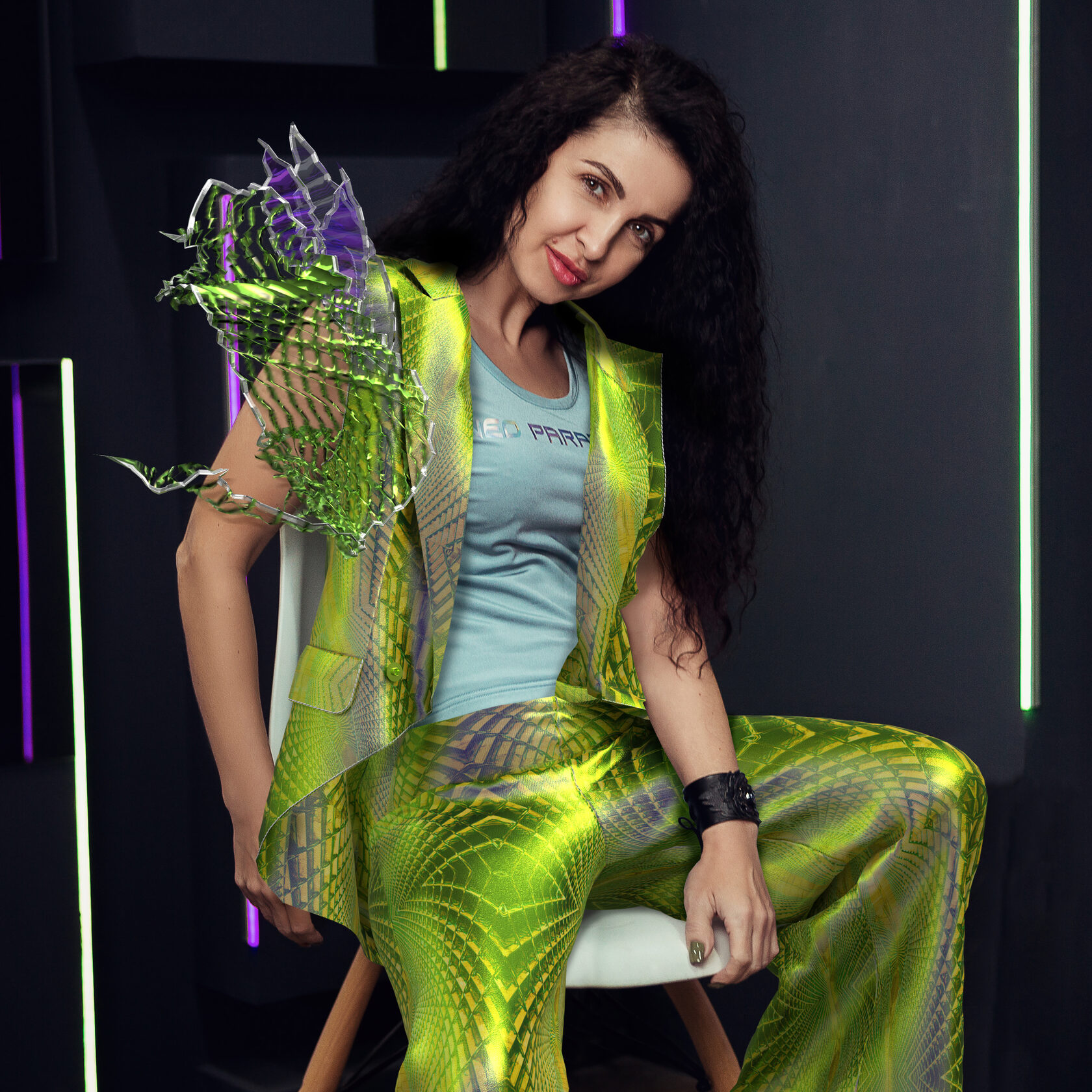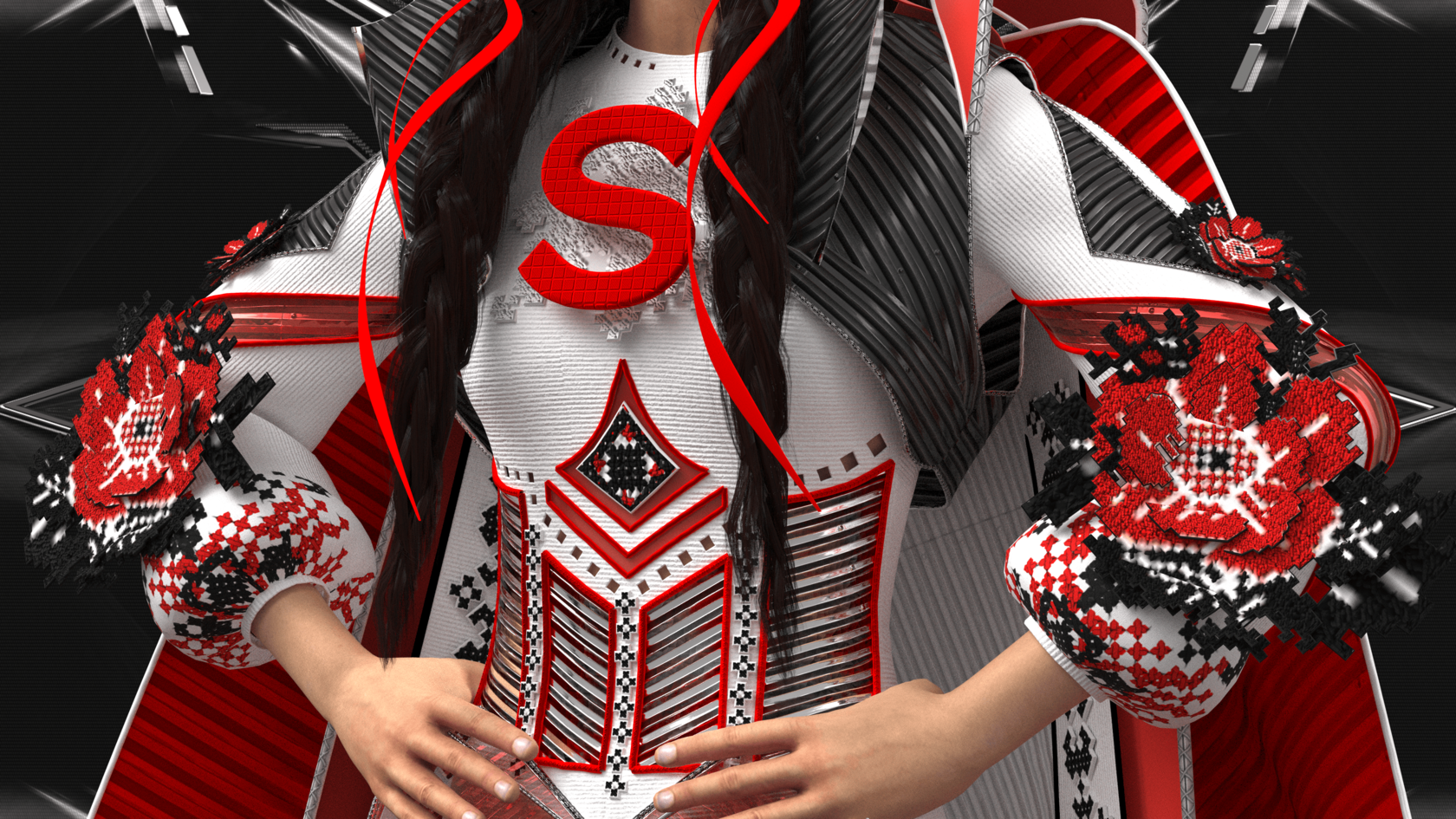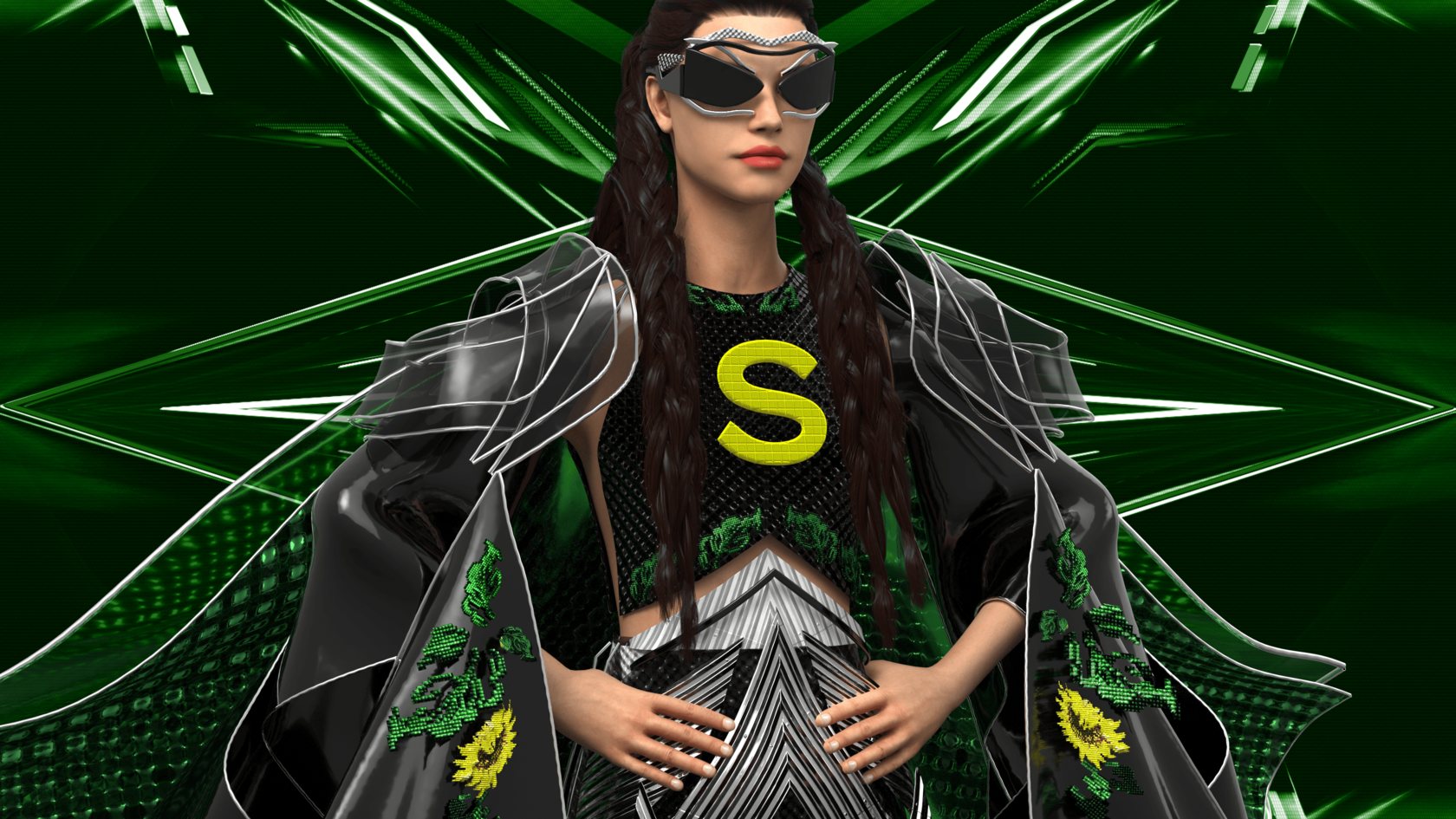Lena Semenenko has always been a visionary when it comes to the question of the future of fashion, as early as 2020 she was already the first designer at the Ukrainian Fashion Week that presented a fully digital collection. Last year, she collaborated with DRESSX to create a unique and engaged collection of digital clothes aimed at educating people on the topic of pollution. Lena Semenenko is a futuristic designer that recently participated in the Metaverse Fashion Fest: THE FUTURE OF FASHION WEEKS IN METAVERSE, April, 27th.
She openly tells about her projects, her vision of Metaverse Fashion, and her plans for the future.
Since last month, Lena, in collaboration with Digital Fashion Week NY, has exhibited her unique NFT collection ''Super Heroes are Ukrainians, available on The Drip, a fashion NFT boutique.
She openly tells about her projects, her vision of Metaverse Fashion, and her plans for the future.
Since last month, Lena, in collaboration with Digital Fashion Week NY, has exhibited her unique NFT collection ''Super Heroes are Ukrainians, available on The Drip, a fashion NFT boutique.

"SUPER HEROES ARE UKRAINIANS"
You are one of the first designers who presented a fully digital collection in 2020. Today, a lot of fashion brands are starting to explore digital creation itself. Could you tell us about your vision of contemporary fashion weeks? Are they going to be fully digital or a dialogue between physical and digital items is going to be established?
At the time it was just an experiment that I proposed to the organizers at my own risk and was very afraid of rejection. There were no such practices in fashion shows at that time, and the only option we had was to show a video broadcast in the hall for the audience with a projector. Today there are a lot of ways for brands to make their fashion shows as exciting and interactive as possible. And this speed of technology is amazing. I don't think that traditional offline fashion shows are going to disappear. We're in for an amazing symbiosis of the physical and digital world. And artificial intelligence, meta universes, and augmented reality will play a big role in that, and I think we're on the cusp of big changes for fashion and for a lot of the areas that intersect with it. I think we can expect the development of technologies that are as realistic as possible. And they can also be available for fashion. At least, that's what I'd like to see. It would be interesting for me to see on the catwalks of traditional fashion shows a symbiosis of live models and the most realistic projections of holograms. For example virtual models of Shudu Gram or fantastic characters. Just a very interesting format of music shows Anyma (Mateo Milleri). Perhaps many have seen it Audio-Visual Show "Genesys" recently in Brazil. Fantastic characters with good detail and animation are broadcasted on very large screens and all this with a game of lights and smoke machines. It creates such an atmosphere that the physical and virtual worlds merge so much that you can not divide them. I think in fashion shows you have to try to give the guest of the show such a fantastic experience of merging the two worlds.
Digital creation drastically changes how items are conceived. For instance, items can be visualized in 3D and pre-ordered, before any physical item is sewed. Do you think digital creation has the potential to transform the industry and integrate the ecological agenda in fashion?
I think that if we talk about the environmental agenda, we should not forget that digital fashion also brings with it carbon emissions. And we cannot say that "Digital fashion is a carbon-free fashion". This is because you need electricity to run a computer. The "thickest" carbon footprint is from fossil fuel (coal or gas) power plants. More environmentally friendly: hydro and nuclear power plants, as well as renewable energy sources. In 2022 my article was published in the Ukrainian magazine Blur. It contains my thoughts on this subject, conclusions, data, and calculations. I have managed to make them based on studies of energy sources, and data from the world and Ukrainian organizations. And also I have developed formulas for calculating the carbon footprint of the creation of 3d products. At various conferences, I have shared with designers more detailed information and my formulas. And if their power plants were working on the same fuel as mine, then they could calculate the carbon footprint of their 3d products using my formulas. If we take at least one example, such as a T-shirt: physical version=6kg CO2, digital version=130g CO2, in any case,, we see very big advantages of the 3d version. Yes, digital fashion will greatly reduce the burden on the environment. Of course, the introduction of 3d technology brands makes conscious and environmentally friendly, both the production and consumption of fashion products. But still, I am in favor of transparency which is why I conducted such studies.
As a designer that has worked with both, physical and digital creation, could you tell us about what changes the most between physical and digital creation of clothing?
Aside from the advantages of digital fashion over physical fashion in its less environmental impact, and saving money in the production stages, for me its biggest advantage is the absence of restrictions on creativity. I've been very confined to the limits of designing physical clothing. I've often been told by brand owners when they saw my designs: "But we are not a haute couture house! We don't need it, we want something simple and everyone will wear it" I understand them, but I lacked creative freedom. With the advent of digital fashion, I realized that this is exactly what I need. There are no limits to the structures of fabrics, to their size, to their comfort for everyday wear for example. There are no restrictions. I think many creative people, many designers will understand what
I'm talking about.
I'm talking about.

You have collaborated with DRESSX to create an exclusive collection called Drifting Diatoms. Would you consider it as a merge of 'futurism' and 'environmentalism'?
Yes, that's right. You're right. Digital fashion will reduce the burden of the fashion industry on the environment. And it was the ecological agenda that was the focus of my collection concepts. Before the war, I probably lectured for two years at various conferences and researched sustainable Biodesign and the impact of physical and digital fashion on ecology. And that's why I wrote concepts for my digital collections on these topics. Two of them are presented at DressX. They are "Ready For Future"- where I think about cities of the future without carbon emissions. And "Drifting Diatoms" where it's about disappearing phytoplankton, which plays an important role in nature and produces half of the oxygen on the planet. And another collection "Anthropocene" is an era of "great acceleration" launched by modern man: the industrial revolution, nuclear explosions, and massive deforestation.
To conclude the first part, could you tell us about your future projects linked to digital creation?
Now I want to acquaint the world more with Ukrainian culture. In the collection "Super Heroes are Ukrainians," I used digital embroidery with Ukrainian folk ornaments, a combination of color palettes close to the national costumes. Now I am preparing the next collection, which will use Ukrainian symbols and many other things that identify our nation.
Do you consider, being part of a DAO like Metaverse Fashion Council is in the best interest of designers?
Yes, Metaverse Fashion Council is a very good example, as I mentioned above. This is the best format. I participated for the first time and realized that this is exactly what is needed, both for designers and brand owners and of course for companies offering technological innovations. Also, it was very cool that after the presentations of all the speakers, there was a round table and everybody could discuss some interesting topics and questions. And Mext Metaverse platform also meets the spirit of the times - guests and speakers can interact with each other, as well as with the presentation stands of the metaverse. It was a very exciting meeting format.

Yes, for pioneers like me at the time it was not so easy to reach and convince companies to introduce 3D models at production stages. But still, I succeeded and we tried to implement such a model: several samples of the same model were sewn for the physical showroom.
Could you please briefly present the project that you are going to present (Super Heroes are Ukrainians)
The collection is dedicated to the memory of my son Danil Semenenko, who died in the war in Ukraine. He is my main Super Hero, who bravely and fearlessly stood in defense of his country until his last breath. He is a Hero of Ukraine and was awarded the Order of Courage.
For over a year, the whole world is watching Ukrainians struggle for a peaceful life, happiness, and freedom. Not a single person on the planet doubts the heroism of this nation. Hardworking, intelligent, talented, kind, and cheerful men and women became brave Heroes in an instant. Defenders of everything that they love so much in their land, that they hold very dear. They became strong in spirit and courageous. They are very real Super Heroes, not from a fairy tale or a comic book, but from our real life.
For over a year, the whole world is watching Ukrainians struggle for a peaceful life, happiness, and freedom. Not a single person on the planet doubts the heroism of this nation. Hardworking, intelligent, talented, kind, and cheerful men and women became brave Heroes in an instant. Defenders of everything that they love so much in their land, that they hold very dear. They became strong in spirit and courageous. They are very real Super Heroes, not from a fairy tale or a comic book, but from our real life.
In your Super Heroes collection, you are using elements of divinity (Perun, God, Heavenly Horses), a Ukrainian traditional skirt (Vyshyvanka), and elements of Futurism. Do you see Ukrainian identity today as a combination of tradition, futurism, and divine powers? Are those elements making Ukrainians Super Heroes?
The history of Ukrainian folk embroidery has its roots deep in the ages. For thousands of years, Ukrainian lands appeared and disappeared from different cultures: Mezinskaya culture, Trypillya culture, and Kievan Rus. They had their symbols that were depicted on religious and household items. These symbols are reflected in the embroidery, which our ancestors adorned the fabrics and clothing. Since ancient times, the Ukrainian embroidered vestment was not just festive, original clothing. She was attributed magical powers. She was considered a kind of amulet. Perhaps it was the ancestors of the Ukrainian people have passed on the genes of fearlessness and strength of spirit to the modern inhabitants of the Ukrainian land. Perhaps our ancestors are guarding, like deities and angels, these lands and will help win the victory of good over evil.
''And it would be cool to have more conferences, where designers and brand founders, founders of start-ups, and well-known companies that offer presentations of innovative technological solutions for the symbiosis of digital and physical fashion, could meet each other.''
Could you tell us, based on your experience, how do traditional brands and organizations (fashion weeks for instance) react to starting to experiment with digital creation? Do you think, as a designer, that digital creators should create communities that will help them achieve their goals?
Before my introduction to digital fashion, I worked for many years as a fashion designer at several large clothing companies. I was very familiar with all the standard production processes. Material consumption during the initial development stages of collection samples, sewing samples for Instagram photos, showrooms, and presenting the collection to buyers. And also piles of unsold items in warehouses from previous collections. Yes, it's not environmentally friendly and it's also an unnecessary expenditure of funds. And yet a more powerful argument for the brand owner was the financial savings. Since 2020, when I began to experience digital fashion, I saw a huge advantage for brands. Yes, for pioneers like me at the time it was not so easy to reach and convince companies to introduce 3D models at production stages. But still, I succeeded and we tried to implement such a model: several samples of the same model were sewn for the physical showroom. The same model was created in 3D but in all kinds of colors and materials. With this 3D model also created content for orders on the brand's website, for a video presentation on Instagram. And if not every brand owner could be convinced to comply with the environmental agenda, everyone noticed and appreciated the saving of money at the stages of launching a collection from production start to sales. As it was possible to avoid unnecessary expenses for sewing a color palette, and unnecessary expenses for photo/video shooting for model presentation. And as for fashion weeks, I would like them to be more technically adapted for virtual shows. Again we can go back to the example, which I have already talked about. Like Anyma music shows. And it would be cool to have more conferences, where designers and brand founders, founders of start-ups, and well-known companies that offer presentations of innovative technological solutions for the symbiosis of digital and physical fashion, could meet each other. Almost all digital designers are faced with the fact that it takes them a long time to explain some obvious things to the customers (to the brand owners, and the organizers of fashion shows).
Metaverse Fashion Council would like to express sincere gratitude to CLARE TATTERSALL, Hanene Maupas, and Galina Ildetkina for their great support of Lena Semenenko and her great talent
Metaverse Fashion Council would like to express sincere gratitude to CLARE TATTERSALL, Hanene Maupas, and Galina Ildetkina for their great support of Lena Semenenko and her great talent
Metaverse Fashion News
- Lena SemenenkoDesigner
READ MORE



